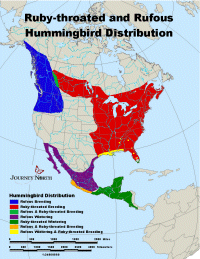|
Hummingbird
Migration Update: March 10, 2005
Migration Maps and Data
Rufous Hummingbirds Push North Another Early Year for Rufous Migration? Challenge Question #3 “ Many (including me) have remarked on the apparent earliness of the migration this year,” says Mike. An early look at the data shows this year to be like 2003, another early year. “To be fair we'll have to wait until after the 90th day for a full accounting. Why? The main movement west of the Cascade Crest usually takes until day 90. But since the peak in normal years is around day 70, we're really not able to make comparisons that represent the entire picture. We need both sides of the bell curve histogram to be fair.” You can see that bell curve on Mike’s histogram/graph.
When you leave on a long car trip, you like to be sure there will be food along the way. Will restaurants be open when you're hungry? You might say that migratory species must count on the same thing. The blooming of flowering plants is an important part of Mike Patterson’s migration study. Scientists have long thought that some of the migratory species we study in Journey North (such as monarch butterflies and hummingbirds) time their migration to match the flowering and fruiting of various food plants. They follow "flower highways" that are nectar trails to fuel their flights. In the process of moving from one plant to another, these flying critters are not only feeding; they are also pollinating.
“ I just returned from Belize, Mexico, where February 24 I observed a Ruby-throated female actively feeding 20 feet from the shore line in 80-degree heat. She seemed no more eager to return to the north than I did,” reports a traveler who lives in Massachusetts. That hummer may still be in Belize, but other Ruby-throats are on the way! The first arrivals were reported Feb. 19, 24 and 26. Here’s how some of you are welcoming your Rubythroats: * Tallahassee, FL (March 3): “First Adult Male Ruby Throated showed up this morning at my feeder at 7:30 a.m. This is 3 days earlier than the last 3 years when a male has shown up on March 6th.” * Wesley Chapel, FL (March 4): “They're here! I put my feeders out March 1. Last year I saw the first one on March 3, but yesterday was cold and rainy. I saw 2 different ones this morning on the feeder outside my bedroom window.” Look at data points on the map and give a statement that describes where Rubythroats were first seen. Where do you think they’ll be reported next? Is it time to put out your feeder? Check the map for migration progress, and see our tips for getting ready:
Last time we introduced you to a molting Rufous hummingbird who was hanging out at Jackie Allison’s flower-filled yard in California. We asked: “Why do you suppose this male hummingbird is molting during winter? (Try to give two reasons why it would benefit the bird.)” Attracting
females is one benefit of new feathers, answered Jharna, Joe, Jasmit,
and Oliver (Iselin Middle School,
Grade 7). Ruchika,
Shannon, Nikita, Hillary, Devin, Serenity, Nicole, and
Megan believe the hummingbird
molts because “his feathers are worn out and no
longer durable and dull-colored wings are not as appealing
to females.” Good
thinking, all of you! Here’s more from Journey
North’s
ornithologist, Laura Erickson:
“ I had never seen nor witnessed the behavior of a migrating hummingbird in molt,” says Jackie Allison of Nipoma, California. But that changed on January 24 when a molting male Rufous settled on her property. She worried that he would leave for his breeding grounds in the Pacific Northwest before she could see the unveiling of his new "colors." What signs told Jackie the little Rufous was molting when he arrived? How did he respond to Jackie and her camera? How long did he stay? What was his behavior like? Did Jackie get to see his new colors? See: Molting takes a lot of energy. Jackie explains why, and how hummer behavior changes during molting. She tells how the hummer “war games” change before and after the Rufous’s new “colors” grew in. See: Got Questions? “Ask the Expert” Opens Next Friday March 18 Once again this year, hummingbird expert Lanny Chambers has volunteered to respond to students' questions. Are you thinking?
How to Respond to Today's Challenge Questions The Next Hummingbird Migration Update Will Be Posted on March 17, 2005. Copyright
1997- 2005 Journey North. All Rights Reserved. |














